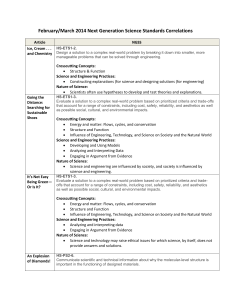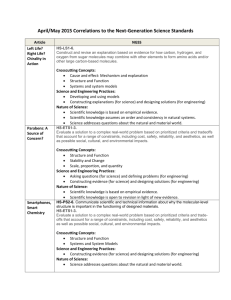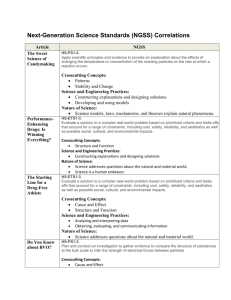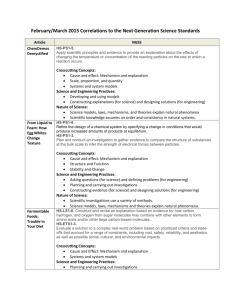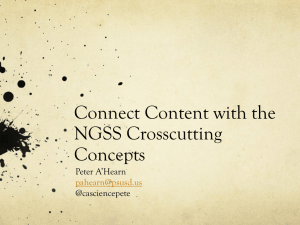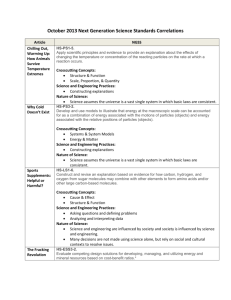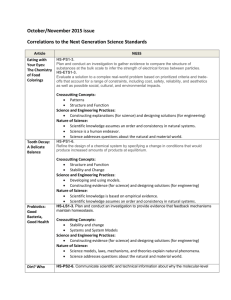Separation of Crosscutting Concerns from Requirements to Design
advertisement
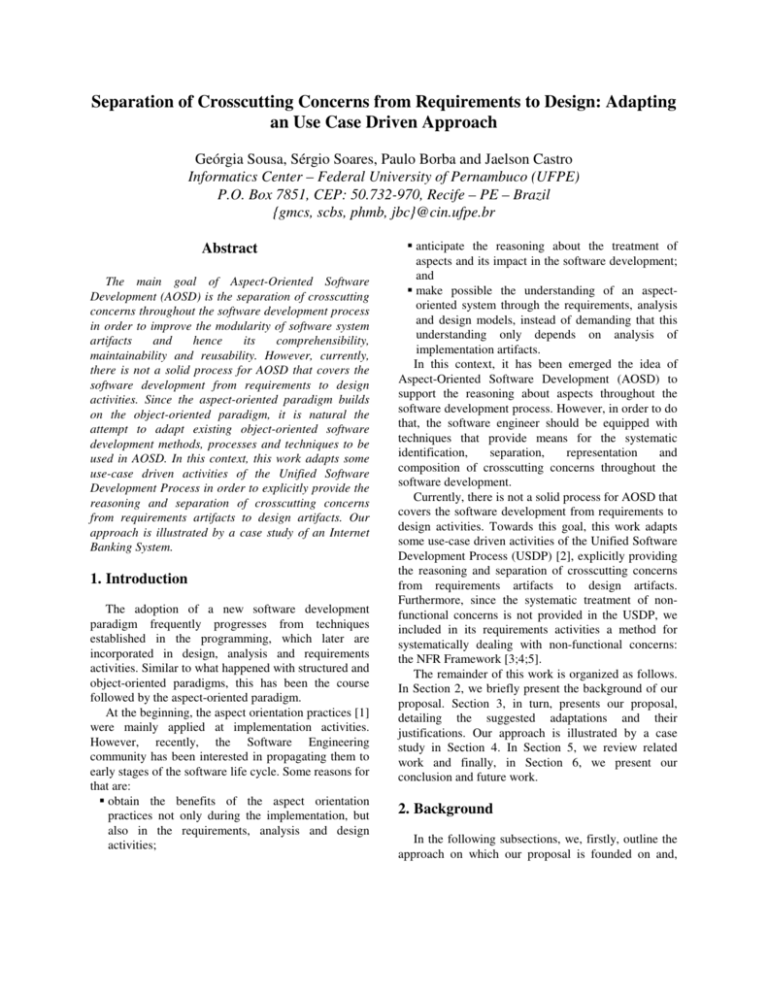
Separation of Crosscutting Concerns from Requirements to Design: Adapting
an Use Case Driven Approach
Geórgia Sousa, Sérgio Soares, Paulo Borba and Jaelson Castro
Informatics Center – Federal University of Pernambuco (UFPE)
P.O. Box 7851, CEP: 50.732-970, Recife – PE – Brazil
{gmcs, scbs, phmb, jbc}@cin.ufpe.br
Abstract
The main goal of Aspect-Oriented Software
Development (AOSD) is the separation of crosscutting
concerns throughout the software development process
in order to improve the modularity of software system
artifacts
and
hence
its
comprehensibility,
maintainability and reusability. However, currently,
there is not a solid process for AOSD that covers the
software development from requirements to design
activities. Since the aspect-oriented paradigm builds
on the object-oriented paradigm, it is natural the
attempt to adapt existing object-oriented software
development methods, processes and techniques to be
used in AOSD. In this context, this work adapts some
use-case driven activities of the Unified Software
Development Process in order to explicitly provide the
reasoning and separation of crosscutting concerns
from requirements artifacts to design artifacts. Our
approach is illustrated by a case study of an Internet
Banking System.
1. Introduction
The adoption of a new software development
paradigm frequently progresses from techniques
established in the programming, which later are
incorporated in design, analysis and requirements
activities. Similar to what happened with structured and
object-oriented paradigms, this has been the course
followed by the aspect-oriented paradigm.
At the beginning, the aspect orientation practices [1]
were mainly applied at implementation activities.
However, recently, the Software Engineering
community has been interested in propagating them to
early stages of the software life cycle. Some reasons for
that are:
obtain the benefits of the aspect orientation
practices not only during the implementation, but
also in the requirements, analysis and design
activities;
anticipate the reasoning about the treatment of
aspects and its impact in the software development;
and
make possible the understanding of an aspectoriented system through the requirements, analysis
and design models, instead of demanding that this
understanding only depends on analysis of
implementation artifacts.
In this context, it has been emerged the idea of
Aspect-Oriented Software Development (AOSD) to
support the reasoning about aspects throughout the
software development process. However, in order to do
that, the software engineer should be equipped with
techniques that provide means for the systematic
identification,
separation,
representation
and
composition of crosscutting concerns throughout the
software development.
Currently, there is not a solid process for AOSD that
covers the software development from requirements to
design activities. Towards this goal, this work adapts
some use-case driven activities of the Unified Software
Development Process (USDP) [2], explicitly providing
the reasoning and separation of crosscutting concerns
from requirements artifacts to design artifacts.
Furthermore, since the systematic treatment of nonfunctional concerns is not provided in the USDP, we
included in its requirements activities a method for
systematically dealing with non-functional concerns:
the NFR Framework [3;4;5].
The remainder of this work is organized as follows.
In Section 2, we briefly present the background of our
proposal. Section 3, in turn, presents our proposal,
detailing the suggested adaptations and their
justifications. Our approach is illustrated by a case
study in Section 4. In Section 5, we review related
work and finally, in Section 6, we present our
conclusion and future work.
2. Background
In the following subsections, we, firstly, outline the
approach on which our proposal is founded on and,
later, we outline the method whose activities will be
part of our proposal.
2.1 Use case driven activities in the Unified
Software Development Process
In an use case driven development [2; 6], use cases
not only represent system functional requirements, but
also guide the development effort in producing
requirements, analysis, design, implementation and test
models. In the sequel, we present some use case driven
activities that should be performed to produce the first
three of these models in the Unified Software
Development Process.
The analysis model describes the system using a
kind of abstraction named analysis classes. Analysis
classes represent an early conceptual model for entities
in the system that have responsibilities and behavior.
They eventually evolve into classes and subsystems in
the design model. There are three kinds of analysis
classes: boundary, control and entity. Each one has its
own purpose, modeling one specific role of a system
component.
Figure 2 exhibits the flow of the main use case
driven activities that should be performed to produce
the analysis and design model.
2.1.1 Requirements Activities
Figure 1 presents an outline of the main use case
driven requirements activities proposed by the Unified
Software Development Process.
Figure 2 – Analysis and Design activities
Figure 1 – Requirements activities
Firstly, we have to understand and to describe the
most important business concepts and events in the
problem context that the system is supposed to solve.
The next activity is to identify system actors, i.e. users
and other systems that will communicate with the
system. The interactions that take place between an
actor and the system should be identified by means of
use cases. In the following activity, each use case
should be specified in more detail. The last activity is
to structure use cases not only to enhance its reuse and
understanding, but also to prepare for the transition to
the next models.
2.1.2 Analysis and Design Activities
The analysis and design activities focus on
describing the internal behavior of the system that was
required to realize the use cases.
Firstly, for each use case description, it should be
identified boundary, entity and control classes and the
responsibilities of each one. The following activity is to
describe the use case behavior in terms of the
interaction among the analysis objects. This interaction
can be expressed using two types of interaction
diagrams: sequence and collaboration diagrams [7]. In
the sequel, design entities should be identified;
depending on the type of the analysis class (boundary,
entity, or control) there are specific strategies that can
be used to create initial design classes (details in [2]).
Attributes, operations and methods for each design
class also should be specified in this activity. The last
activity is establishing dependencies and associations
between design classes; important inputs for this
activity are the interaction diagrams and classes
specifications.
2.2 NFR Framework
The NFR Framework [3;4;5] is a systematic
approach to dealing with non-functional requirements
(NFRs). In this approach, non-functional concerns (e.g.
security, performance) are treated as goals to be
achieved.
Figure 3 exhibits the sequence of activities
suggested by the NFR Framework. Firstly, each nonfunctional concern1 is iteratively decomposed into ones
that are more specific. At some point, when the concern
has been sufficiently refined, it will be possible to
operationalize it, i.e. providing more concrete and
precise mechanisms (e.g. operations, business rules,
design decisions) to achieve it. The last step is to select
among the operationalizations: accepting ( ) or
rejecting ( ) each of them. During refinement and
operationalization steps, contributions and possible
conflicts should be established, defining the impact of
the non-functional concerns to each other and
identifying priorities (indicated by “!” or “!!”).
3.1 Requirements activities
Figure 4 exhibits the requirements workflow
emphasizing the adaptations provided by our proposal.
In the following subsections, we describe each one of
these adaptations and its justifications.
Figure 4 - Requirements Activities of Our Proposal
3.1.1 Activities focused on non-functional concerns
Figure 3 - NFR Framework Activities
In the NFR Framework, non-functional concerns,
their interdependencies and operationalizations are
graphically represented in a Softgoal Interdependency
Graph (SIG).
3. Proposal outline
The aspect-oriented paradigm builds on the object
oriented paradigm (OOP) in order to support the
separation of those concerns that OOP handles poorly
[8]. Then, it might be worthwhile to adapt existing
object-oriented methods and techniques instead of
creating a new approach for AOSD.
In this context, this paper adapts some use-case
driven activities of the Unified Software Development
Process [2] in requirements, analysis and design
workflows. The purpose of our approach is to provide
mechanisms that support the separation of crosscutting
concerns in artifacts of these workflows.
In the following sections, we explain and justify
each one of the adaptations that were accomplished.
Since non-functional concerns are generally
crosscutting, their adequate treatment is an important
step in Aspect-Oriented Software Development.
However, they are superficially taken into account in
use case driven approaches. Then, in order to
systematically deal with non-functional concerns since
the early stages, we have included the NFR Framework
[3;4;5] activities (presented in Figure 3) in the
requirements workflow.
Throughout the NFR framework activities, each
non-functional concern (e.g. security, reliability,
performance) is broken down into smaller ones and
then converted into operationalizations (i.e. operations
and design decisions) that together contribute for
achieving the non-functional concern. We also included
an activity responsible for specifying in detail these
operationalizations: the operations should be specified
as the same way as use case are; the design decisions
can be placed in special sections in the requirements
document.
For each operation identified in this activity, it
should be defined which use cases they applied to.
3.1.2 Activity: Structure artifacts
This activity uses the following structuring
mechanisms to model shared behavior and extensions
1
In the NFR Framework, non-functional concerns are named
softgoals
among use cases: generalization, include-relationship
and extends-relationship.
Jacobson [9;10] advocates that the use case
extension mechanism can be used to model aspects in
requirements activities: an extension use case would be
equivalent to an aspect and extension points would be
equivalent to join points. However, we prefer to
provide a new structuring mechanism to model aspects
in requirements activities because:
(i) the extension mechanism can be used in
situations in which the extension use case does
not represent a crosscutting behaviour in the
system. For example, when the extension use
case represents a complex and alternative
course that is specific of a base use case (e.g
Figure 5); and
(ii) the way as extension points are defined hinders
the reuse and comprehension of the base and the
extension use case. According to UML
guidelines [7], the possible extension points are
specified in the base use case and there should
be references to these points in the extension use
case. Therefore, since there are references in the
base and also in the extension use case, the
composition between an extension and a base
use case can not be completely considered
noninvasive.
Figure 5 – Extension example (reproduced from [7])
Thus, we propose a new way to separate
crosscutting behaviour in use cases: (i) the crosscutting
behaviour will be placed in a use case apart, named
crosscutting use case; (ii) the crosscutting use case will
be connected to the use cases it affects by means of a
new kind of relationship, named crosscuts; and (iii)
information about the composition between an
crosscutting use case and the use cases it affects will be
described apart from both, in a composition table (see
Table 1).
For each crosscuts-relationship, it should be
specified one composition table. Besides providing
better reuse and comprehensibility, the composition
table simplifies determining the range of use cases that
a crosscutting use case affects and how it affects each
one of them.
Table 1 –Composition table for a crosscutting use case
CROSSCUTTING USE CASE: # N <NAME>
The crosscutting use case should be identified at the
table’s top with its number and name. The first column
of the composition table should list all use cases that
the crosscutting use case affects. The second column
describes the condition of the composition. This
condition can be omitted if the composition should
always be executed. The third column determines how
the behavior of a crosscutting use case should be
applied to the affected use case. For this purpose we
use the following operators [11]: overlap (before or
after); override and wrap.The last column of the
composition table, in turn, specifies to which point of
the affected use case the crosscutting behavior should
be applied. In the requirements workflow the points are
specified in terms of steps of the scenario.
We use the following heuristics to decide which
relationship is more adequate to structure two use cases
(use case A and use case B):
if the execution of the use case B is an essential part
to accomplish the primary purpose of the use case
A (i.e. the use case A depends on the use case B to
accomplish its goal), then the use case A includes
the use case B;
if the execution of use case B represents a complex
and alternative course that is specific of the use case
A, then the use case B extends the use case A;
if the execution of use case B represents a course
that needs to be applied in the use case A, but (i)
the use case A do not depends on the execution of
the use case B to accomplish its primary goal; and
(ii) the use case B is not a specific course of the use
case A and therefore it can be applied in others use
cases; then the use case B crosscuts the use case A.
Generally, the operationalizations of non-functional
concerns have a crosscuts-relationship with use
cases.
3.2 Analysis and Design Activities
Our proposal has made modifications in all the
analysis and design activities presented in Figure 2. In
the following subsections, we explain each one of these
modifications and its reasons.
3.2.1 Activity: Find Analysis Classes
Finding a candidate set of analysis classes is the first
activity towards a description of how the system will
work. Each analysis class should represent specific
behavior of an entity that collaborates to fulfill the use
cases. Since, in our proposal, we consider the
crosscutting behavior as a separated entity, we include
a new kind of analysis class to represent it: crosscutting
class.
For each crosscutting requirement identified in the
Structure artifacts activity by means of the crosscutsrelationship, it should be created a crosscutting class.
A crosscutting class can represent one or more analysis
classes necessary to concretize a crosscutting
behaviour.
3.2.2 Activity: Describe Analysis Objects Interaction
When the analysis classes have been identified and
specified, it is necessary to describe for each use case
how its corresponding analysis objects interact in order
to realize its behavior. Generally, this interaction is
represented in collaboration diagrams.
In this activity, we want to support the separation of
crosscutting concerns in the interaction diagrams.
Then, crosscutting objects that affect analysis objects
interactions should not be placed directly in the
interaction diagram. Instead, information about how a
crosscutting object will affect analysis objects
interactions should be described in a composition table
(see Table 2).
This table provides more precise details about the
composition of crosscutting concerns that the one
provided by Table 1. Here we describe the composition
by means of analysis objects and messages affected by
a crosscutting object.
Table 2 – Composition table for a crosscutting object
CROSSCUTTING OBJECT: <NAME>
It is worthwhile to mention that the composition
table for a crosscutting object can generate a view of an
interaction diagram aware of the crosscutting objects.
This view is important for the designer/implementer of
the crosscutting behavior.
3.2.3 Activity:Identify and Specify Design Elements
In general, a crosscutting class will generate at least
one aspect in design model. However, this is not a
general rule: a crosscutting class can be designed with
existing mechanisms such as design patterns. The
designer will choose the better solution according each
particular situation.
Since aspects are characterized by adding to
class(es) new behavior or new structure, we use a
stereotyped class <<aspect>> to model an aspect The
crosscutting behavior will be modeled as operations
and new structure as properties in the aspectual class.
In order to preserve the reusability and maintainability
of the aspectual class, we continue using the idea of
composition tables (see Table 3) to determine the join
points and the composition rules.
Table 3 – Composition Table for an aspectual class
ASPECTUAL CLASS: <NAME>
#
#$ %
!" !
!
$
&
'"( !
By means of the composition table for crosscutting
objects (Table 2) and the knowledge achieved in the
previous activities, it will be possible to specify in a
specific composition table (Table 3) the details about
how the aspectual class will modify each affected class.
3.2.4 Activity: Define Relationships
In order to fulfill this table, we start taking each
composition table that was specified in the requirement
model (see Table 1). Then, for each crosscutting
requirement, we analyze the interaction diagrams of the
use cases affected by it. So, we can specify the join
points by means of messages intercepted by the
crosscutting object.
Analyzing the composition table of an aspectual
class, it is possible to determine the classes affected by
it. To model the relationship between an aspect and the
classes affected by it, we defined a kind of association
relationship: crosscuts.
4. Case Study
We apply our proposal to an Internet Banking
System. In the sequel, we outline how our proposal can
be used throughout the requirements, analysis and
design activities. In this case study, we focus only on
the activities that were modified or included by our
approach.
4.1 Requirements Activities
Table 4 -View Account Statement Use Case Specification
USE CASE # 02 - VIEW ACCOUNT STATEMENT
)
+
!
"
#
$
"
#
*
At first, we have identified an actor (Bank
Customer) and four use cases that this actor can
accomplish (View Account Balance; View Account
Statement; Transfer Funds; and Pay Bill). Simplified
specifications for some of these use cases are presented
in Table 4 and Table 5.
!
USE CASE # 03 – TRANSFER FUNDS
)
4.1.1 Activity: Specify Use Cases
*
Table 5 - Transfer Funds Use Case Specification
+
,
#
!
#
4.1.2 NFR Framework Activities
One of the most important non-functional concerns
when building information systems to be used on the
Internet is security. As we can see in Figure 6, after the
successive
decompositions,
the
following
operationalizations were selected to achieve the
security concern: Limit Transaction Value, Firewall,
Data Encryption, Identification, Check Internet
Password, Check Customer Personal Data, Duplicate
Servers, and Mirror Database.
Figure 6- Softgoal Interdependency Graph for Security non-functional concern
4.1.3 Activity: Specify Operationalizations
Due to space limitation, we only show in this work
the specifications for the Check Internet Password
Operationalization (see Table 6).
Table 6 –Specification for Check Internet Password
Operationalization
OPERATIONALIZATION # 05 – CHECK INTERNET PASSWORD
MAIN SUCCESS SCENARIO
STEP ACTION
1
The actor informs the Internet Password
2
The system compares the informed Internet Password with the
account’s Internet Password
3
The output of the comparison is returned
4.1.4 Activity: Structure Artifacts
In this activity, we use the available mechanisms
(generalizes, include, extends and crosscuts) to
structure shared and crosscutting behavior among the
requirements artifacts previously described. We use the
heuristics presented in Section 3.1.2 to decide which
relationship is more adequate to use.
Figure 7 shows graphically the output of this
activity.
crosscuts-relationship between the Charge Tax and the
Make Financial Transaction use cases.
After that, we analyzed each operationalization and
identified which use-cases each one should affect. As
functional and non-functional requirements have
different purposes, when an operationalization needs to
be applied to a use case, we have a crosscutting
relationship.
The
following
crosscutting
operationalizations were identified: Check Internet
Password, Check Customer Personal Data, Limit
Transaction Value and Data Encryption.
For each crosscuts-relationship, we should specify
how to compose the crosscutting use case and the
affected use cases. Table 7 and Table 8 show some of
these specifications.
Table 7 – Composition for Check Internet Password
CROSSCUTTING REQUIREMENT: #05-CHECK INTERNET PASSWORD
AFFECTED ARTIFACT
COND.
COMPOSITION
RULE OPERATOR
AFFECTED
POINT
#01 – View Account Balance
-
overlap.before
Step 1
#02 –View Account Statement
-
overlap.before
Step 2
#03 – Transfer Funds
-
overlap.after
Step 1
#04 – Pay Bill
-
overlap.after
Step 1
Table 8 – Composition for Charge Tax
CROSSCUTTING REQUIREMENT: #06 – CHARGE TAX
AFFECTED ARTIFACT
COND.
COMPOSITION
RULE OPERATOR
AFFECTED
POINT
#03 – Transfer Funds
-
overlaps.after
Step 3
#04 – Pay Bill
-
overlaps.after
Step 3
4.2 Analysis and Design Activities
In the next subsections, we follow the analysis and
design activities for the Internet Banking System
including the adaptations provided by our proposal. In
this section, we focus only on the Transfer Funds use
case and in the Check Internet Password crosscutting
use case.
4.2.1 Activity: Find Analysis Classes
Figure 7 – Structured Use Case Diagram
First, we have analyzed the use cases. Doing this,
we have identified some possible generalizations and
one include-relationship between the Emit Confirming
Receipt and the Make Banking Transactions use cases.
Since after each financial transaction, the bank should
charge a tax to the customer account, there is a
In this activity we identified the following analysis
classes which will be capable of performing the
behavior described in the Transfer Funds use case:
• Boundary: Input Data User Interface (UI)
• Entity: Account
• Control:
Transfer
Handler;
Transference
Information Valuator; and Confirming Receipt
Emitter.
There are also some crosscutting classes that will
affect the realization of the Transfer Funds use case:
Check Internet password, Limit transaction value,
Charge tax, Check customer personal data.
4.2.2 Activity: Describe Analysis Object Interaction
By means of an analysis of the Transfer Funds use
case, we have obtained the collaboration diagram
presented in Figure 8. This diagram should be used by
the designer/implementer of this use case and therefore
it is oblivious about the crosscutting objects that will
affect its behavior.
Figure 9 – Crosscutting View of the Transfer Funds
Collaboration Diagram
4.2.3 Activity: Identify and Specify Design Entities
Figure 8 – A Collaboration Diagram for a realization
of the Transfer Funds use case
Nevertheless, in the point of view of the
designer/implementer of the crosscutting behavior it is
interesting to visualize how crosscutting objects will
affect the interaction of analysis objects. As explained
in Section 3.2.2, in order to obtain this crosscutting
view of the interaction diagrams, we have to determine
the join points in terms of messages intercepted by the
crosscutting object. Table 9 presents this specification
for the Check Internet Password crosscutting class.
Table 9 – Composition Table for Check Internet
Password Crosscutting Class
CROSSCUTTING CLASS: CHECK INTERNET PASSWORD
AFFECTED ARTIFACT
AFFECTED
ANALYSIS
CLASS
#03 – Transfer Funds Input Transfer
Data UI
AFFECTED
MESSAGE
COMPOSITION
RULE OPERATOR
request transfer
overlap.before
Analyzing the composition table of each
crosscutting class that affects the Transfer Funds use
case, it can be generated a crosscutting view of Figure
8. Figure 9 presents this crosscutting view, considering
only the Check Internet Password crosscutting class.
We decided to organize the design model in well
defined layers, according to the nature of the
application concerns: interface, façade, business and
data. This architecture is based on the object-oriented
layer architecture [12].
By means of the artifacts and the knowledge
achieved in the previous activities, we identified the
InternetPasswordChecking aspect and its properties, as
exhibited in Table 10.
Table 10 – Composition Table for Internet Password
Checking Aspectual Class
ASPECTUAL CLASS: INTERNET PASSWORD CHECKING
CROSSCUTTING PROPERTIES
AFFECTED
CLASS
Transaction
Facade
DYNAMIC
STATIC
Composition
Rule Operator
Affected
Point
Crosscutting
Behavior
-
overlap.before
doTransfer()
checkInternet
Password()
4.2.4 Activity: Define Relationships
Lastly, Figure 10 presents the graphical
representation of the crosscutting relationships between
two of the aspects identified and the classes they affect.
Figure 10 - Relationships between Design Entities
5. Related Work
Currently, there are few works concerned with the
provision of development techniques for separation of
crosscutting concerns from requirements to design. One
example of this kind of work is presented by
Constantinides [13]. He emphasizes the importance of
identifying and modeling crosscutting concerns since the
early stages of the software life cycle. Constantinides’
work presents a case study to investigate the modeling of
crosscutting concerns, mainly in analysis and design
activities. However, although Constantinides proposes to
adapt established analysis and design techniques for an
aspect-oriented context, he only describes how
crosscutting concerns can be visualized in sequence and
classes diagrams, not suggesting techniques for
developing these artifacts.
Jacobson [9;10] advocates that the use case
extension mechanism has a similar purpose to aspects
in AOP and that this mechanism could be used in
requirements activities for AOSD. But, as we show in
Section 3.1.2, there are some difficulties using this
mechanism that we overcome.
Rashid et al. [14; 15] propose a generic process
model for Aspect-Oriented Requirements Engineering
(AORE), but do not explore the link with analysis and
design activities. After that, Moreira et al. [11] and
Araujo et al. [16] presents a simplified model to
support the general AORE process described in [14];
these works compose non-functional and functional
requirements using extensions of the use case and
sequence diagrams. One of the characteristics that
differs these works in AORE from our approach in the
requirements activities is the treatment of nonfunctional concerns. They deal with non-functional
concerns in a high-level of abstraction. On the other
hand, we provide a systematical treatment of nonfunctional concerns before analyzing their crosscutting
behavior:
firstly
refining
them
and
later
operationalizing them in more concrete and precise
mechanisms. We advocate that it is more adequate to
deal with operationalizations in the context of AspectOriented Requirements Engineering because they better
reflect how the crosscutting concerns will be treated in
the latter stages [17].
In turn, one of the first proposals to extend the UML
for aspect design was presented by Suzuki and
Yamamoto [18]. That work extends the UML
metamodel including a new kind of classifier named
aspect. To model the aspect-class relationship, Suzuki
and Yamamoto advocate the use of a kind of
dependency
relationship
with
stereotyped
realization,<<realize>>, already provided by UML.
However, in their work, Suzuki and Yamamoto present
a notation only for inter-type declarations, not
mentioning how pointcuts or advices can be modeled
with the UML. Furthermore, they focus on design
activities, not exploring the link with previous
activities.
6. Conclusion
Scattering and tangling do not occur only in
implementation artifacts. They emerge in other artifacts
throughout the development process. For this reason, it
is necessary to apply the separation of crosscutting
concerns in all development stages. As a result, the
comprehensibility, maintainability and reusability of
software system artifacts are improved. Furthermore,
the explicit capture of crosscutting concerns throughout
all development stages can also enable developers to trace
crosscutting
concerns
from
requirements
to
implementation artifacts.
Nevertheless, in spite of the importance of
identifying and modeling crosscutting concerns
throughout the development process since the early
stages, few works address this issue. This paper
presents a contribution to this context by means of the
adaptation of some use-case driven activities of the
Unified Software Development Process [3] in
requirements, analysis and design workflows.
As showed by our case study (Section 4), our
proposal provides a way to separate crosscutting
concerns at various levels of abstraction, from
requirements to design.
This work is a first step towards a complete
adaptation of the Unified Software Development
Process in order to provide separation of crosscutting
concerns in its workflows. Our future work will focus
on improving our approach and applying it in more
case studies.
7. References
[1] Kiczales, G.; Lamping, J.; Mendhekar, A.; Maeda, C.;
Lopes, C.; Loingtier, J.-M. and Irwin, J. (1997)
“Aspect-Oriented Programming”. In Proceedings of
ECOOP ‘97, Springer-Verlag.
[2] Jacobson I., Booch G., and Rumbaugh , J. (1999) “The
Unified Software Development Process”, AddisonWesley, ISBN 0-201-57169-2.
[3] Mylopoulos, J.; Chung, L. and Nixon, B. (1992)
“Representing
and
Using
Non-Functional
Requirements: A Process-Oriented Approach”. IEEE
Transactions on Software Engineering, Vol. 18, No. 6,
June, pp. 483-497.
[4] Chung, L; Nixon, B.; Yu, E. and Mylopoulos, J. (2000)
“Non-Functional
Requirements
in
Software
Engineering”. Boston:Kluwer Academic Publishers,
ISBN 0-7923-8666-3.
[5] Mylopoulos, J.; Chung, L.; Liao, S.; Wang, H. and Yu,
E. (2001) “Exploring Alternatives during Requirements
Analysis”. IEEE Software Jan/Feb, pp. 2-6.
[6] Jacobson, I; Christerson, M; Jonsson, P. and Overgaard,
G. (1994) “Object-Oriented Software Engineering: A
Use Case Driven Approach”. Addison Wesley, ISBN 0201-54435-0.
[7] Booch, G.; Rumbaugh, J. and Jacobson, I. (1999) “The
Unified Modeling Language User Guide”. AddisonWesley.
[8] Elrad, T.; Aksit, M.; Kiczales, G.; Lieberherr, K. and
Ossher, H. (2001) “Discussing Aspects of AOP”.
Communications of the ACM, 44(10):33–38, October.
[9] Jacobson, I. (2003) “Use Cases and Aspects – Working
Seamlessly Together”, in Journal of Object Technology,
vol. 2, no. 4, July-August, pp. 7-28.
[10] Jacobson, I. (2003) “Use Cases - Yesterday, Today, and
Tomorrow”. The Rational Edge, March.
[11] Moreira, A.; Araújo, J. and Brito, I. (2002)
“Crosscutting Quality Attributes for Requirements
Engineering”, 14th International Conference on
Software Engineering and Knowledge Engineering ,
ACM Press, Italy, July.
[12] Ambler, S. (1998) “Building Object Applications that
Work”. Cambridge University Press and Sigs Books.
[13] Constantinides, C. (2003) “A case study on making the
transition
from
functional
to
fine-grained
decomposition”. ECOOP 2003 Workshop on Analysis
of Aspect-Oriented Software (AAOS 03), Darmstadt,
July 21.
[14] Rashid, A.; Sawyer, P.; Moreira, A. and Araújo, J.
(2002) "Early Aspects: a Model for Aspect-Oriented
Requirements Engineering", IEEE Joint Conference on
Requirements
Engineering,
Essen,
Germany,
September.
[15] Rashid, A. Moreira, A. and Araujo, J. (2003).
“Modularisation and Composition of Aspectual
Requirements”. AOSD 2003, ACM, pp. 11-20.
[16] Araújo, J.; Moreira, A.; Brito, I. and Rashid, A. (2002)
"Aspect-Oriented Requirements with UML", Workshop:
Aspect-oriented Modeling with UML, UML2002,
Dresden, Germany.
[17] Sousa, G.; Silva, I. and Castro, J. (2003) “Adapting the
NFR Framework to Aspect-Oriented Requirements
Engineering”. XVII Brazilian Symposium on Software
Engineering, Manaus, Brazil, October.
[18] Suzuki, J. and Yamamoto, Y. (1999) "Extending UML
with Aspects: Aspect Support in the Design Phase", In
Proceedings of the 3rd Aspect-Oriented Programming
(AOP) Workshop at ECOOP'
99, Springer LNCS 1743.
